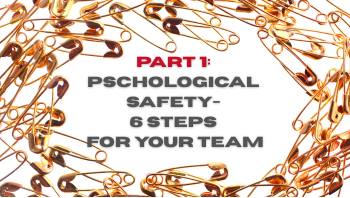Speaking confidently, acting boldly: How teams build psychological safety - Part 1
Psychological safety is not a “nice to have”, but an essential prerequisite for productive, innovative and resilient teams.
It enables employees to express themselves openly, recognise mistakes as learning opportunities and contribute fully.
But psychological safety does not happen by chance! It must be consciously developed and structurally anchored. It is crucial to understand that it cannot be ‘manufactured’: It results from the way people interact with each other. Managers cannot therefore directly determine that a team feels safe, but they can create the conditions that enable psychological safety.
In this two-part article, we describe the two crucial dimensions needed to achieve this:
- Behavior and processes: How can a team quickly create psychological safety? What specific measures help to establish an open, trusting atmosphere? (Part 1)
- Structures and systems: What clear rules, roles and frameworks are necessary to ensure psychological safety in the long term? (Part 2)
Part 1: The classic approach
Psychological safety is the key to productive, innovative and resilient teams. But how can it be created quickly and sustainably? Studies, including those by Amy Edmondson (Harvard Business School), show that psychological safety not only significantly increases the well-being but also the performance of teams. At the same time, research shows that trust is a prerequisite - without a basis of trust, psychological security is unlikely to develop.
Here are the six central steps to establishing a safe environment from the outset:
Psychological safety in the team: the 6 most important steps to building it quickly
Psychological safety is the key to productive, innovative and resilient teams. But how can it be created quickly and sustainably? Studies, including one by Amy Edmondson (Harvard Business School), show that psychological safety significantly increases not only the well-being but also the performance of teams. Here are six key steps to establishing a safe environment from the outset:
1. Set clear expectations:
A team needs a common basis. Managers or team members should communicate early on that questions, criticism and new ideas are not only allowed, but expressly encouraged. A simple but effective formulation could be: ‘Here in the team, mistakes are learning opportunities. We deal with them openly.’ It is important that reliability exists as a basis - only those who trust that openness will not be used against them can actively participate.
2. Exemplify openness:
People orientate themselves by role models. When managers or influential team members openly admit that they don't know everything or make mistakes themselves, this creates trust. An example: ‘I overlooked an important point in the presentation. Thanks for pointing that out, it helps us all.’ What is crucial here is that openness does not mean that managers ensure the safety of each individual, but that they create the framework conditions in which team members feel safe enough to be open.
3. Active listening and asking questions:
Psychological safety often fails because ideas or concerns go unheard. Active listening, i.e. genuine interest and asking questions, signals appreciation. Practical tip: In meetings, consciously ask questions such as ‘What have I overlooked?’ or ‘Are there other perspectives?’. At the same time, it is important that team members are not only ‘honest’, but are also aware of how they communicate their perceptions. Instead of saying ‘You don't respect me’, it might be more helpful to say: ‘When you interrupt me, I wonder whether my opinion counts for you.’
4. Consciously manage how you deal with mistakes:
Error culture is more than just a buzzword. The decisive factor is how mistakes are reacted to. A defensive attitude (‘Who is to blame?’) destroys trust. A learning-orientated attitude (‘What can we learn from this?’) strengthens it. Google is a good example of this: in the ‘blameless postmortems’ concept, mistakes are analysed without assigning blame.
5. Establish inclusive decision-making processes:
Regular, constructive feedback helps to build trust. A simple format is ‘stop-start-continue’ feedback: ‘What should we do more of, do less of (no longer), keep doing?’ And actively involve team members in decision-making processes: This appreciation of all perspectives strengthens trust in the team.
6. Demonstrate trust and communicate clearly:
Strong leadership means not only security and direction, but also flexibility. Teams benefit when managers set an example of clear but open communication. This means not avoiding conflicts, but resolving them constructively and fostering a culture of honest, respectful feedback. At the same time, psychological safety must not be confused with harmony: different positions and friction are normal and often necessary to achieve progress.
Psychological safety does not happen by chance – it is the result of conscious action. By consistently implementing these steps, you create an environment in which people dare to give their best.
Sources & practical examples:
Edmondson, Amy C. (2019). The Fearless Organization: Creating Psychological Safety in the Workplace for Learning, Innovation, and Growth. John Wiley & Sons.
Google's Project Aristotle (2016): https://rework.withgoogle.com/en/guides/understanding-team-effectiveness
Download: re_Work Manager Actions for Psychological Safety
Preview of Part 2:
So far, so good! But all of this is not enough if the framework conditions are not right. Clear roles, defined rules and a transparent structure are necessary to enable psychological safety not only in the short term, but to anchor it sustainably in the team. How? Read part 2 to find out!


About me

All Rights Reserved
Get in touch
-
+49-(0)941 600 93 003
-
This email address is being protected from spambots. You need JavaScript enabled to view it. -
Thomas_Huber
ToChange Gmbh
-
Thomas Huber
-
Traubengasse 6
-
D-93059 Regensburg

